
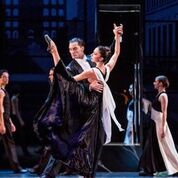 Highly Recommended ***** Anybody who is kicking themselves for missing the Chicago premiere of Krzysztof Pastor’s production of Sergei Prokofiev’s Romeo and Juliet has a chance for redemption this October. In a modern-dress production presented as part of the Shakespeare 400 Festival, the Joffrey Ballet and the Chicago Philharmonic dance and play so elegantly that the emotional arc of Shakespeare’s most famous work comes through clearly even without his words. Pastor’s vision is, however, very much his own adaptation, and within Prokofiev’s score, he has made some key alterations to the story which make it fresh and intuiting, as well as making full use of the tools of dance to convey dramatic characterization.
Highly Recommended ***** Anybody who is kicking themselves for missing the Chicago premiere of Krzysztof Pastor’s production of Sergei Prokofiev’s Romeo and Juliet has a chance for redemption this October. In a modern-dress production presented as part of the Shakespeare 400 Festival, the Joffrey Ballet and the Chicago Philharmonic dance and play so elegantly that the emotional arc of Shakespeare’s most famous work comes through clearly even without his words. Pastor’s vision is, however, very much his own adaptation, and within Prokofiev’s score, he has made some key alterations to the story which make it fresh and intuiting, as well as making full use of the tools of dance to convey dramatic characterization.
This vision of this Verona spans the 1930s to the 1990s, with the upheavals of fascism, the social division of the communists against the governing parties, and the tangentopoli scandals forming the background of the Capulet family’s opposition to Romeo and his friends. Set and costume designer Tatyana Van Walsum introduces us to a black and white colored street scene with archival footage of the period immediately preceding World War II, and we first see Romeo, Mercutio, and Benvolio (Rory Hohenstein, Yoshihisa Arai, and Alberto Velazquez at opening) impressing each other with high, sweeping kicks—the physical equivalent of their verbal banter in Shakespeare’s version. But their day is soon darkened by the arrival of the black-clad Capulets, including Tybalt (Temur Suluashvili), whose movements are aggressive and militaristic. The Montagues—such as they are, since none of Romeo’s relatives are ever seen—respond in kind, and our introduction to Juliet (Christine Rocas) is her somber premonition of carnage.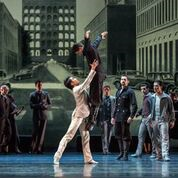
Actually, Mercutio and Tybalt have several duets, and for the most part, Tybalt seems to enjoy having a competitor pay him so much attention. It’s old Capulet (the massive Fabrice Calmels) who is the tuxedo-clad source of all the animosity. Pastor uses “The Dance of the Knights,” the most famous section from this work of Prokofiev’s, as Capulet’s personal motif, and Capulet’s choreography is made up of all whirling sharp angles which he uses to drive everyone else from the center of the stage. Tybalt is only dangerous when acting on Capulet’s direct orders in defense of Juliet, which is, of course, a complete inversion of their relationship in Shakespeare, and one which arguably makes for a less complex tragedy. But it works in the context of the hypnotic force conductor Scott Speck puts into the entire scene of the Capulets’ ball, and in the absence of a Prince-figure or any apparent political inclinations on the Montegues’ part, it seems that Capulet is the type of totalitarian who regards neutrality as enmity.
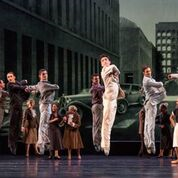 Also in the pivotal ballroom scene, we see the contrast between Juliet and Romeo’s worlds clearly expressed through their differences in dance. The Capulets are archaically formal, moving in full, slow circles, but once Juliet meets Rome in the balcony, her movements are quick and flighty. It seems odd to call ballet in a tragedy cute, but Pastor’s staging of Romeo and Juliet’s first private duet seems to have been most heavily inspired by the word “blushing,” and cute they are. They’re choreography naturally involves lots of entangled limbs and torsos, but from Hohenstein and Rocas’s acting, it is apparent that Romeo and Juliet’s attraction is based on a juvenile, but quite sincere, emotional connection. They really do look like a pair of fourteen-year olds. Following intermission and a time-skip to the 1950s, Friar Lawrence (Dylan Gutierrez) takes command of the situation by assuming the masculine role in his duet with Romeo. Yet Capulet is somehow aware of his daughter’s secret marriage, and it is he who introduces the knife which is the sole implement of death in Pastor’s staging.
Also in the pivotal ballroom scene, we see the contrast between Juliet and Romeo’s worlds clearly expressed through their differences in dance. The Capulets are archaically formal, moving in full, slow circles, but once Juliet meets Rome in the balcony, her movements are quick and flighty. It seems odd to call ballet in a tragedy cute, but Pastor’s staging of Romeo and Juliet’s first private duet seems to have been most heavily inspired by the word “blushing,” and cute they are. They’re choreography naturally involves lots of entangled limbs and torsos, but from Hohenstein and Rocas’s acting, it is apparent that Romeo and Juliet’s attraction is based on a juvenile, but quite sincere, emotional connection. They really do look like a pair of fourteen-year olds. Following intermission and a time-skip to the 1950s, Friar Lawrence (Dylan Gutierrez) takes command of the situation by assuming the masculine role in his duet with Romeo. Yet Capulet is somehow aware of his daughter’s secret marriage, and it is he who introduces the knife which is the sole implement of death in Pastor’s staging.
Pastor’s ending is incredibly cynical, and I wasn’t as clear on his intention with the scenes set in later time periods. However, his vision and the Joffrey’s production are overall a great success. Prokofiev was one of the first great composers for movies (he was reworking Romeo and Juliet during the same years he was writing the score to Sergei Eisenstein’s Alexander Nevsky), and his music has a sophisticated dramatic sensibility to which the Chicago Philharmonic does full justice. The dancers entirely inhabit a clearly different world, while making it accessible to us through nuances of movement which display their characters’ personal quirks and feelings. And though Pastor made his own changes and there’s not a word of Shakespeare’s in the dance, the characters are still recognizably descended from Shakespeare’s, preserving the humanism which is truly what makes him a beloved writer in countries where he is mostly known through translation. The Joffrey’s production is a prime example of why this story has remained popular for hundreds of years, and being so plot-centric, can delight those who are new to ballet as much as those who are regular attendees.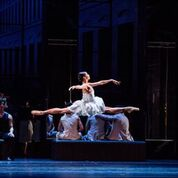
The Joffrey Ballet’s Romeo & Juliet will run at the Auditorium Theatre, 50 E Congress Parkway, Chicago, through October 23. Running time is two hours and ten minutes, with one intermission. Performances are as follows:
Thursday, October 20 at 7:30 pm
Friday, October 21 at 7:30 pm
Saturday, October 22 at 2:00 pm and 7:30 pm
Sunday, October 23 at 2:00 pm
Tickets are $34-174. The Joffrey Ballet’s box office is in 10 E Randolph St, and can be reached at 312-386-8905 or Joffrey.org.
To see what others are saying, visit www.theatreinchicago.com, go to Review Round-Up and click at “Romeo & Juliet.”

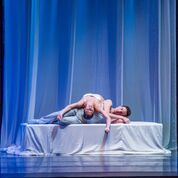





More Stories
“Guys & Dolls”
“The Music Man”
“The S Paradox” reviewed by Julia W. Rath